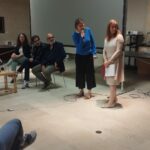The Tea Party, Sarah Teresa Jakob, Monaco
Mention Prix Energheia Germany Award 2021
Suddenly a White Rabbit with pink eyes ran close by her. There was nothing so very remarkable in that; nor did Alice think it so very much out of the way to hear the Rabbit say to itself, ʻOh dear! Oh dear! I shall be late!ʼ
Alice’s Adventures in Wonderland, Lewis Carroll
This Rabbit was supposedly the first animal to feel pressed by time – or rather the lack of it. It can surely be considered as a being which lived quite ahead of its time.
1865 – the most frequently used means of transport was the carriage but change was on the way as railways started to roll fairly fast across the countryside.
The Liverpool and Manchester Railway enjoyed the benefits of having a very well-paying guest who could be found in every train that departed from Liverpool and steamed its way to Manchester. On arrival this most appreciated guest worked his way up from the first to the last carriage of the train and waited anxiously for its departure back to Liverpool. Some ignorant people would call him mad but one should hear his story before judging this rather exceptional behaviour.
His name was Sir Douglas Aldridge of Cheshire, better known as The Duke of Time. Sir Douglas loved railways. They made everything faster, swifter, more convenient and he adored the feeling of craning his neck out of the window and talking to his caring friend Lady Cecilia Westham or The Duchess of Speed, as she was commonly referred to. The crux of the matter was that the Duke of Time and the Duchess of Speed felt a strong attachment for each other but the only way the Duke could spend some exhilarating hours with his Duchess was through moving excessively fast. Imagine what the railway meant for their cautiously sprouting relationship! Before Stephenson constructed the locomotive, horse races had been the only way for Time to correspond with Speed.
Now, one has to understand the importance of the Duke of Time to the people. Interestingly, the faster he moved the slower his servants – the seconds – followed. They were simply exhausted. One can imagine how startled people and rabbits must have felt about this alteration. The velocity of time passing by should never again be something one could predict.
Of course, the Duke of Time and the Duchess of Speed have long been married now. This momentous event took place at the launch of the first jet fighter – in the first jet fighter. I dare say one could imagine a more romantic ceremony, but the noise was not at all detrimental to the bliss of them being united in this firm way, a feeling they had never had the chance of experiencing before.
It is needless to say that this delightful couple lost no time in blessing the world with their charming offspring – at least that’s what they thought but unfortunately the children didn’t turn out quite as delightful as the parents. Their names were Dorian, Prince of the ʻBurn-out syndrome and other stress-correlated diseasesʼ and Lillian, Princess of smart Phones. Dorian was a failure from the beginning. He could not do anything right and he was so extremely slow! Whenever mummy and daddy wanted to go on a trip with him he refused because he felt so horribly exhausted and worn out by all those Formula-1 races and jet fighter parades. Time and Speed didn’t know what to do with Burn-out. They simply could not understand how they could have created the complete opposite of themselves! When he was six years old they gave up their great educational efforts and sent him to the Montessori School where he could sit in a corner and talk to an equally worn-out-feeling rabbit. In the future the Duke and Duchess should find out that this had been the only sensible way to react because the anxious rabbit and Prince Dorian were to found a support group for ʻManagers, Nobility and Rabbits suffering from the Burn-out syndromeʼ.
Nevertheless the Duke of Time and the Duchess of Speed were very relieved when their second child arrived showing no abnormal behaviour. Lillian was an angel – she was very slim, had snow-white skin, black hair and was awfully sociable. With her one couldn’t connect fast enough. She hated to be on her own – according to various Tweets – and she hated doing only three things at a time. Her day wasn’t complete until she had read all the latest statements of influencers, actors, virologists and politicians on any topic imaginable – and had commented on them, watched three films and skimmed ten reports about forest decline – and had written a statement on the incompetence and responsibility of every living being for this development, chatted with several friends summing up her latest projects and achievements, knocked the stuffing out of her three managers via Zoom for not protecting her against negative comments on her posts that had obviously been manufactured by the most intolerable people imaginable! One manager after another joined Dorian’s support group. Finally, when the buzz of the day slowly subsided, Lillian always solved a numbers game and various riddles which she found very relaxing, since they had been made for normal people and her intellectual capabilities were far beyond that level.
At first her parents had been enchanted by their daughter’s social agility but then they began to realize that this very ability was dependent on electronic devices and that the more Lillian was connected with the world the more she lost interest in jet fighter parades. The Duke and Duchess even got into quarrels when discussing their daughter – and this was most unfortunate for the entire population. Whenever their marriage suffered a dip the Duke refrained from seeing his wife, which meant that he did not move at all and this in turn seemed to spike the energy of his servants, the seconds, and people constantly felt pressed by time, behind on their tasks and never worked efficient enough to meet the demands of daily life, let alone to enjoy a relaxed evening. Hence, an advisor had been installed whose only task was to take care of the marital well-being of Time and Speed – for their marital crisis had become an issue of public health.
Having heard about the distress she caused to an entire population, the reader might imagine Lillian as a most disagreeable person. Yet, I beg you not to mistake her for one because in fact she was a highly intelligent and a very logically thinking girl – with a weakness for contributing her opinion and solving riddles. Unfortunately, these specific character traits should become a trap for the young lady.
One day a Facebook event popped up. Lillian was invited to a tea party. Actually the idea of a tea party didn’t sound like much of an excitement to her but over the years a great fear of missing out had been growing in the mind of this young person and so Lillian simply could not bear to miss a party – even if it was a tea party in the middle of nowhere.
Having arrived in her self-driving limousine deep in a forest somewhere in Cheshire she walked up to a small garden gate. She reached for the handle. The door didn’t open. Rust had glued the door to its frame. Behind the small fence a crooked sign said: ʻWelcome, dear guest, to the March Hare’s tea party – feel free to be as mad as you like!ʼ So at least she knew now that Google Maps hadn’t sent her the wrong way. The content of this message seemed a little bewildering though. ʻHello?ʼ she called into the wild. No answer. She could have easily climbed over the gate but her manners – and her dress – forbade her to do such a nasty thing. ʻMay I help you?ʼ Lillian flinched. Where did this voice come from? Suddenly, she saw something moving above her. A cat was softly moving its tail, double the size of her body and her mouth dissolved into a wide grin. ʻOh. Good afternoon. Well, I’d like to attend the tea party but the door is rusted up.ʼ ʻOh, of course it is. No one has bothered to use it in centuries. Let me help you.ʼ Elegantly the cat jumped on the fence and began to lick the door handle. Then it gave the door a soft push with its tail and it opened with a grumpy sounding crunch. ʻIf you pleaseʼ said the cat, grinning, her tail waving toward the garden.
Most astonishing, thought Lillian and entered. Despite her distrust the garden which she had just entered looked very lovely and romantic to her eyes – romanticism was not a feeling she had experienced often behind the various screens of her life. She felt the urge to take a picture. She was about to post it – and her romantic contemplations immediately ceased. Her phone had no reception what-so-ever. Completely shocked by this incident Lillian wanted to hasten back to her limousine but a remarkably thin and at the same time powerful voice stopped her: ʻWhy is a raven like a writing-desk?ʼ it demanded. She turned, and underneath a big oak she perceived three creatures sitting round an uneven, antique-looking table. At the head of the table sat a Hare, next to him a small man, with an enormous nose, wearing an old dirty hat that much exceeded his person and lastly Lillian discovered a little mouse sleeping at the edge of the table right underneath their elbows. The March Hare, the Mad Hatter and the dormouse were having tea.
Why is a raven like a writing-desk? Logically thinking Lillian froze underneath the oak tree. She focused. Her thoughts raced. Electric signals jumped from the left to the right brain hemisphere in split seconds. Lillian had never refused a challenge – after all she did not want to be perceived as slow or inefficient or incapable or idle or sickly like her brother! Why did it take so long to calculate this answer? The March Hare and the Mad Hatter watched in amusement. The dormouse had transferred to a filled teacup, she was taking a hot bath and had fallen asleep again. Rose-water mint tea was her favourite bathing essence. Lillian’s head started to run hot. Her cheeks were glowing, a stark contrast against her otherwise albino white skin. Her gaze was feverish. Who had made up this riddle? The Mad Hatter had spoken it out loud but was it a test for her intelligence? Her ability to calculate all the possibilities until finding the correct answer? Any answer? A number of possible answers? What was that round thing on the table? Was that a stopwatch? Who was testing her? Was it her parents? They had always been so kind, so proud. Why would they do that? Had she been away too much? Had they become uncertain of her abilities? But she had always stayed connected with them! Her posts documented her life, her achievements, her vigour! No matter what she had done or where she had been! Or was it this recently established ʻCommittee for Ensuring the Transparency of the Nobility and Safeguarding the Competence of Influencers for the Enhancing Good Governance Practices in the Nation and Beyondʼ? A completely unnecessary job creation effort for bureaucrats, in Lillian’s opinion. She would not have been surprised for them to come up with this setting and riddle. Or was it easy in fact? Was it an easy task, merely a sham that her parents had thought of to test her ambition? Or to legitimize their decision to install her as the only heir and disregard her brother? He surely could not solve this riddle! But was she failing as well? How could she be failing? She was the daughter of the Duke of Time and the Duchess of Speed! She had attended the most well-renowned universities of the country. She had read logic and rational thought – accompanied by the constant praise and astonishment of her professors. Graduating summa cum laude at the age of 16. Lillian became weary. She sat down. On the soil, covered with moss. She forgot her education, her manners, etiquette. All the energy was in her head, focused on one task. No electrons left to keep her on her feet, no calculating power to consider the social norms of the nobility.
Lilian stayed in that garden. Determined and convinced that she would not inherit, that she would be an outcast of the noble class, that she would lose her standing, her reputation, everything she considered her life if she did not solve that riddle. Days passed. Weeks. From time to time the March Hare, the Mad Hatter and the dormouse brought tea and biscuits to her spot on the ground. The biscuits were made of pepper-paste – prepared by the peppered Duchess, delivered by a sneezing piglet. As soon as the piglet arrived the March Hare and the Mad Hatter got all excited. ʻOhhh boy, oh boy who do we have here?ʼ The two of them joined into what looked like a ritual dance around the piglet. The dormouse woke up, shook itself dry from the rose-water mint tea, mounted the piglet, clang on to its left ear while the piglet started to vault rhythmically in a circle like a bull in a rodeo that had developed a passion for dance. Squeaking in joy the dormouse exclaimed: ʻTake me to Mars, piglet! Let’s break the boundaries of spacetime!ʼ
The March Hare approached Lillian and asked: ʻYoung Lady, why don’t you pause your brooding and join us in our little dance?ʼ Lillian was unamused by the word ʻbroodingʼ – what a derogatory term for her calculation efforts! – but she was especially unamused by the chaotic and noisy mess around her surely aimed at distracting her from the task. She grumbled ʻHow kind of youʼ and continued to stare into blank space.
If she had stood up, if she had turned around, she could have read the back side of the crooked welcome sign at the fence. It said: Organization for the De-Rationalization of the Country (ODRC). Make nonsense great again!
And if she had let her gaze wander even more freely, she might have perceived a White Rabbit with pink eyes sitting, very relaxed, next to his rabbit hole at the edge of the garden sucking a lollipop and humming a song. The refrain was: ʻThey smell of raspberry! Ohhhh, they both smell of raspberry…ʼ









